Which garden tree is absolutely perfect for you?
How to choose the right garden tree?
I think we all dither over this because trees seem like such a big purchase. More like buying a sofa than buying a vase, for example.
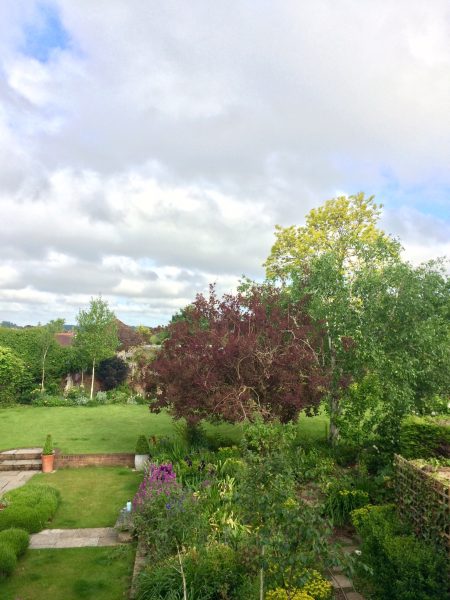
My three favourite trees – the yellow leaves are Robinia frisia (False acacia), the red is Cotinus coggyria ‘Grace’ and the on the right is a Silver Birch ‘Jacquemontii’. They are all quite tall, so they give a ‘middle-sized’ garden a sense of proportion. However, if I had a different garden, I wouldn’t necessarily choose these three.
So we turn to the lists – the 8 perfect-for-privacy garden trees, for example. But these don’t always take into account your soil or situation. However, they’re a good start…note down any tree that appeals to you, but carry on with the research.
Choosing the perfect garden tree
You need to ask yourself – and/or a qualified gardener, tree grower or other professional – three questions. Firstly, what trees will grow well in your climate and soil? If your area is particularly dry, wet or windy, these factors will really affect which trees will do well.
Secondly, how big do you want the tree to grow? You can grow larger trees in small spaces, but you will have to keep them pruned and trained, so that adds to the maintenance. For ideas on shapes and styles, see Jamie Butterworth’s advice in this post on trees for small gardens.
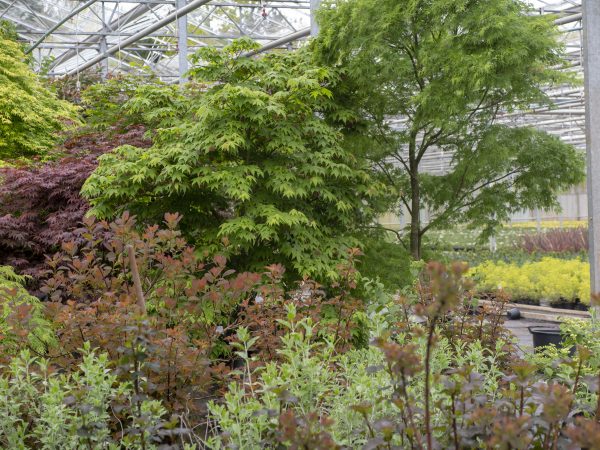
Trees in pots at Hilliers Nurseries in Hampshire. Tree growing nurseries are an excellent place to find advice on which tree is right for you. Visit or talk to several!
Thirdly, do you want an evergreen tree or would you prefer the glorious changes of colour you get with trees that shed their leaves in autumn?
You can answer the second and third questions yourself, but the first will mean looking at neighbours’ gardens and doing an internet search for ‘tree nursery near me’. Ring them up or drop in. There’s nothing like an actual conversation with a real person to give you an idea of what your options are.
Do some research first
Your perfect tree isn’t the same as my perfect tree. So it is worth doing the research rather than making an instant decision. You’ll probably find that the same few tree recommendations pop up several times. So that will be your shortlist – it’s easier to choose from three or four tree varieties than hundreds.
I have bought quite a few trees since moving to this garden fifteen years ago. They haven’t all been successful. I think that’s because I originally made quick decisions from Top 10 lists or the first recommendation I got rather than doing proper research.
For example, acers always feature on the top 10 best trees for small gardens – but I’ve had four acers die in this garden.
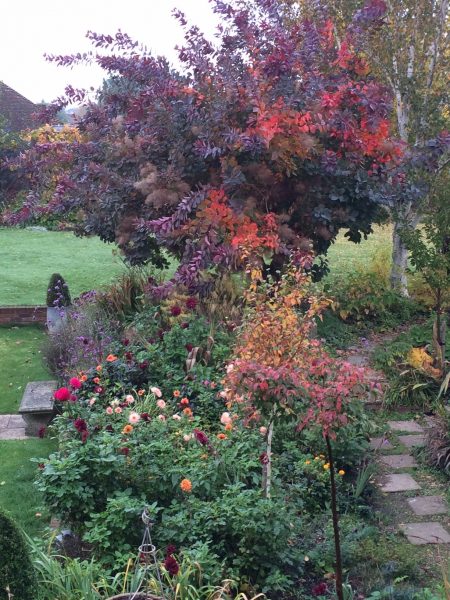
Autumn colour. The small tree in the foreground is a paperbark maple (acer griseum) in the middlesized garden. Beautiful colouring but it always struggled to do well and eventually turned into a brown twig.
Online tree specialists
Many online tree companies have good advice on choosing trees. Barchams have a ‘Tree Finder’.
Hilliers have lists of trees recommended for specific situations, such as ‘car park trees’, ‘drought-tolerant trees’ and ‘narrow crown street trees.’
Practicality Brown also have a tree finder. And the Woodland Trust have a useful listing of garden trees, with their characteristics, including how many centimetres they grow a year.
And even if your particular situation isn’t on the website, you should be able to contact a good tree company by email or phone to ask for advice on a tree for your garden.
If you go to a garden centre or nursery, and they can’t tell you much more than what’s on the label, try somewhere else. Label information is useful but usually too generic.
Buy locally grown garden trees
In the UK we’ve had Dutch elm disease, then ash dieback and now oak processionary moth. Box blight, box tree caterpillar moth and more…they are all consequences of our poor bio-security. Pests and diseases travel easily these days.
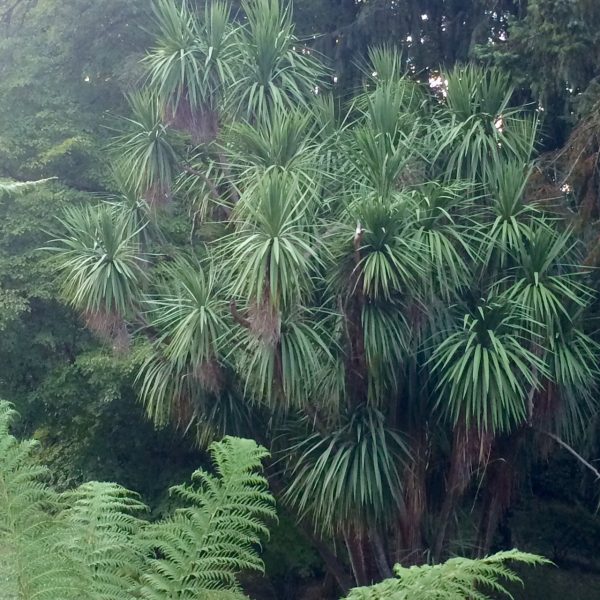
These are New Zealand cordylines growing amongst European pine and fir trees in Australia. They were imported in Victorian times, but bio-security is now very tight.
When I go to Australia the bio-security is extremely tight. You’re not even allowed to bring in muddy boots, let alone plants or uneaten sandwiches or anything that could be called ‘alive.’
In the UK and Europe there are far fewer safeguards. If you live in a country with poor bio-security, buy a tree that hasn’t travelled very far. The RHS now has a list of seven types of plants which can’t be used at its shows unless they are UK grown because they are liable to spread pests or diseases.
And if your tree has been grown close to home, it’ll probably also be more used to your climate and soil. Win, win.
So should I buy ‘native’ garden trees?
‘Native’ trees are not the same as ‘locally grown’ trees. You could buy a Dicksonia tree palm grown locally in Kent, but it doesn’t make it a ‘native’ tree. Silver birch, on the other hand, is a native tree.

An avenue of silver birches at Doddington Place Gardens on a frosty morning. Silver birches are ‘native’ and the top UK trees for supporting diversity and wildlife.
The definition of a ‘native tree’ is one that colonised the UK immediately after the ice age (10,000 years ago) before we were cut off from Europe by the English Channel. These include alder, ash, common beech, blackthorn, hawthorn, hazel and holly, plus many more.
Trees brought in by early settlers (from around 8,000 years ago up to present day) are ‘non-native’. They include Douglas fir, London plane, apple and pear trees and holm oaks, along with many more.
There has been lots of research by the RHS and others as to whether ‘native’ plants and trees are better for wildlife than those which originated elsewhere. Unsurprisingly, the results aren’t entirely clear. The best trees for wildlife and diversity in the UK are silver birch and hawthorn, which are both natives. But most non-native trees are also good.
The important thing, say researchers, is to plant trees. Any tree is better for wildlife than no tree at all.
Can I buy a large garden tree for instant coverage?
A larger, mature tree will have more trouble getting established. A small, young tree may outstrip it over just a couple of years, depending on how good you are at planting a tree properly.
I bought a 3.5 metre Liquidambar styraciflua three years ago. And 1.5 metre Silver birch two years ago. They are now the same size. The liquidambar has been pushed over by the wind several times, so it doesn’t seem to have rooted properly. It’s not looking entirely happy. The silver birch is flourishing.
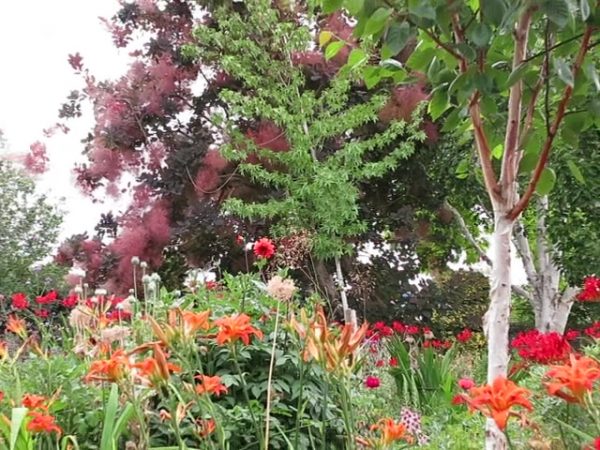
The Liquidambar styraciflua (with the mid-green leaves) has been blown over to the left. We added more staking (it already had three stakes and a pole). It then blew over to the right. It was too tall, and had too big a leaf canopy for the root system. I wish I’d bought one half the size (and price).
A large, mature tree will cost more and has less chance of success. My Liquidambar cost me £149 (I’m so glad Mr Middlesize doesn’t read this blog). The silver birch cost £39.
And if you buy a large tree, you need to invest in a proper tree staking kit, too.
However, specialist tree companies, such as Barcham Trees and Practicality Brown have ways of planting mature trees that gives them a much better chance of survival.
If you want a large, instant mature tree, pay an expert to plant it. Otherwise buy small, young trees.
The best time to plant trees is between October and March.
How much do trees cost?
I did some research on the cost of a silver birch. You can buy a 40-60cm high silver birch from Tree-shop for less than £3 or one that’s 150-180cm high for £31.
If you want a larger tree, you can get a 3-4.5 metre silver birch from Ornamental Trees for £159. More unusual mature trees can cost several hundred – or even thousands – of pounds.
Not all trees survive, however carefully you choose. It may be worth planting two or three smaller trees, with a view to taking one or more out when they get bigger.
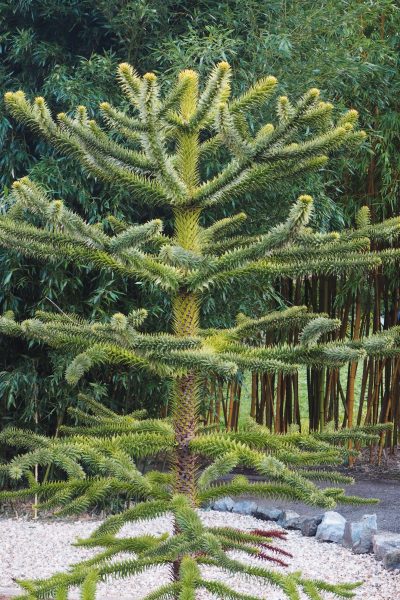
This monkey puzzle tree is about 7ft high. My friends Anne and Mark grew it from seed, and had it in a pot for 2-3 years. It’s now about five years old. A 60-90cm tree would cost around £100 from a shop, so this would be several hundred.
It’s essential to plant your tree properly
Once you’ve chosen the perfect tree for your garden, it’s essential to plant it properly. Tree planting isn’t difficult but there are a few key tips you need to know. See Jamie Butterworth’s advice on how to plant a tree here.
See trees in video
I’ve made a video about choosing your garden tree. It has a tour of the trees in my garden, how we chose them and what we did right or – more often – wrong.
It may help you when deciding on which tree to choose, or you may find that you already have your perfect garden tree if you cut it into shape. Some of the points made in this post are repeated at the beginning of the video, so if you want to skip to the garden tree tour, then fast forward to 2 minutes, 38 seconds.
Let me know what your best and worst garden tree experiences have been, either in the comments below or on Twitter or Facebook. And if you love trees, do share this – we need as many gardens to grow trees as possible. Thank you!
Pin for reference:
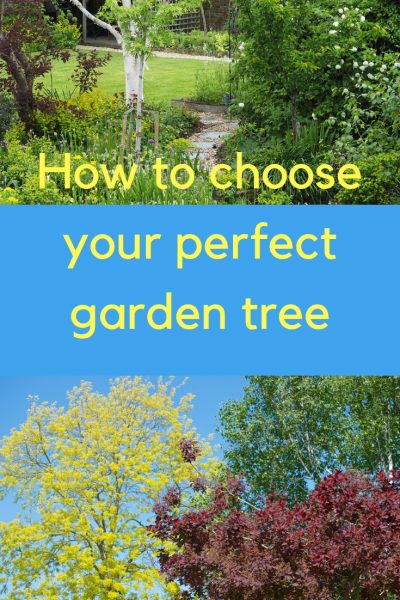
























Appreciate the camera zooming in (for detail) and out.
Thank you